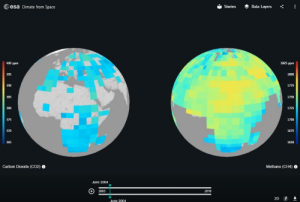The Carbon Cycle
In this set of three activities, students will learn about the carbon cycle and use it to identify actions at the individual and community level to reduce the amount of carbon being emitted to the atmosphere. A practical activity using household materials considers the impact of ocean acidification, allowing students to design a more precise experiment to carry out in a laboratory setting. In the final activity, students use real climate data in the Climate from Space web application to investigate a question about one part of the carbon cycle.
Subject Science, Chemistry, Biology, Earth Science, Geography
- Learn to create a diagram showing the carbon cycle, including fast and slow components
- Use the carbon cycle to identify actions to reduce human-induced climate change
- Structure a scientific explanation of why such an action is likely to have an impact
- Empathise with the viewpoints of others
- Describe the effect of increased ocean acidity on marine organisms
- Evaluate experimental techniques and estimates, extending existing methods to find additional information
- Use the Climate from Space web application to investigate a question related to the carbon cycle
- Select key information to inform others

- Student worksheet 2 (3 pages)
- 3 jars or beakers per group
- 2 bottles or smaller jars per group
- Distilled vinegar – enough to half-fill the larger jar or beaker and fill both bottles or smaller jars
- Lemon or lime juice – to half-fill one jar
- 4 eggshells per group
- 2 balloons per group
- Eye protection
- Cloths or paper towels
- Tweezers or forceps

Did you know?
Human activities are contributing to global warming by increasing the amount of carbon dioxide (CO2) in the atmosphere and adding to the greenhouse effect. Scientists warn that there will be many negative consequences for humans, economies and the natural world, if this continues. Many people have, therefore, started making changes to reduce their carbon footprint. They may be avoiding flying, using the car less, thinking about the impact of the food they eat or avoiding products that are produced by destroying rainforests.

The Magic of Light – Using spectroscopes and colour wheels to study the properties of light
Brief description In this set of eight activities, pupils work individually or in groups to build a spectroscope that can...
Astro farmer
Brief description:In this set of six activities, students will investigate which factors affect plant growth, and relate these factors to...
Nose up high in the sky – Observing and measuring weather conditions
Brief description In this set of three activities, students will learn how their senses and instruments can be used to...


